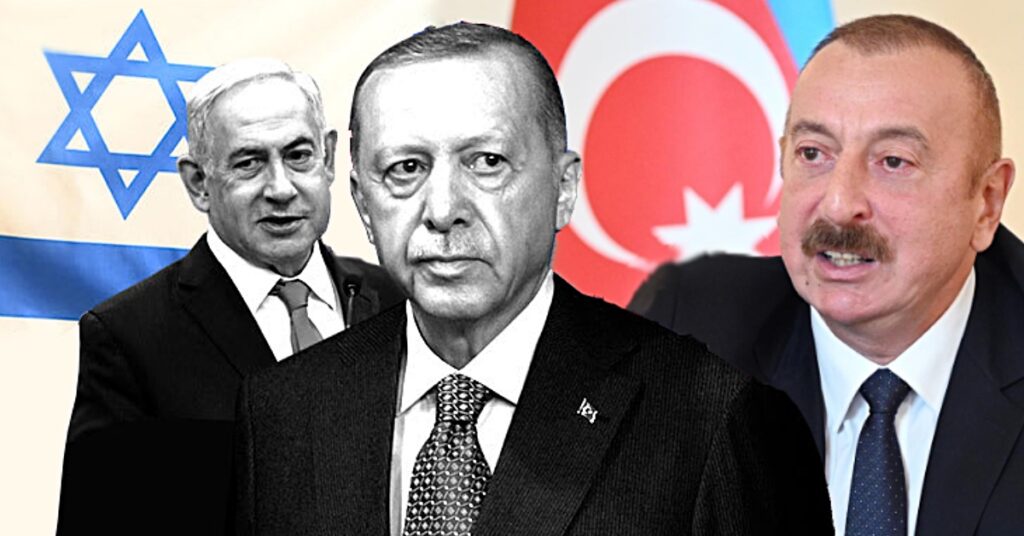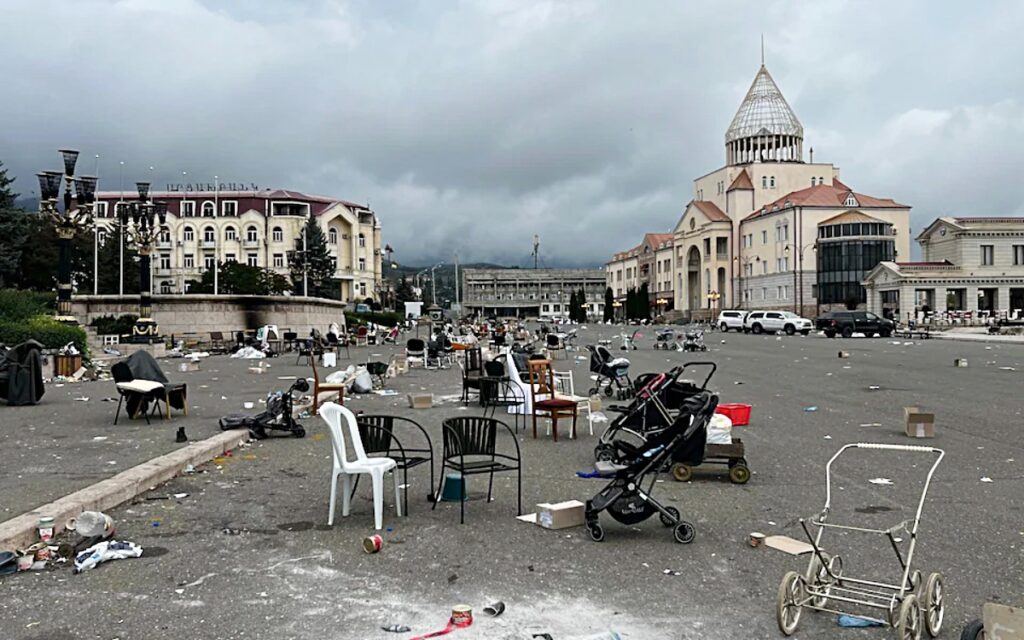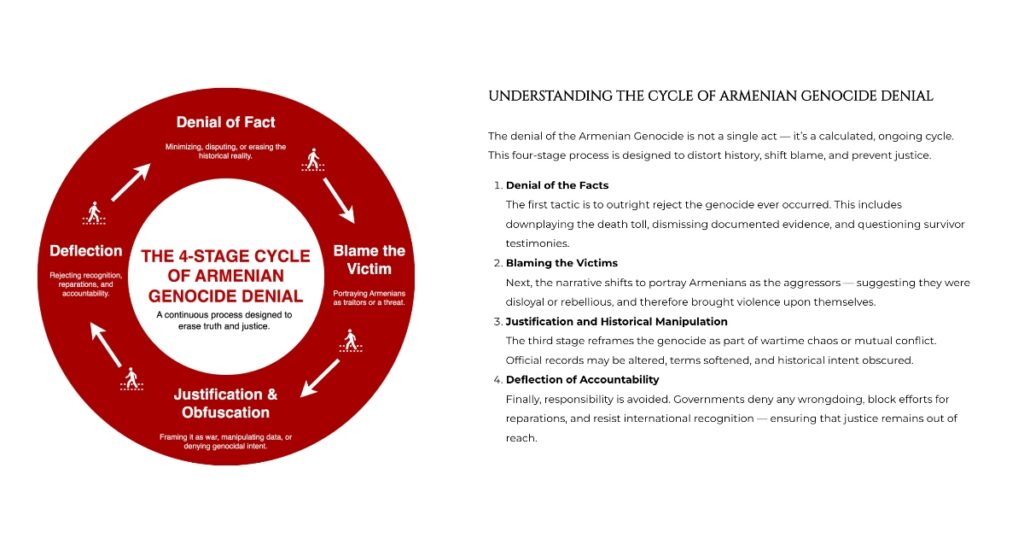When authoritarian leaders collaborate, the result is never accidental. The ethnic cleansing of 120,000 Armenians from Artsakh and the destruction of Gaza are bound together not only by their cruelty, but also by the political, military, and strategic bonds that link Israel’s Benjamin Netanyahu, Azerbaijan’s Ilham Aliyev, and Turkey’s Recep Tayyip Erdoğan. These leaders thrive on fear, rely on military aggression, and exploit silence from the international community. Their collaboration reveals a regional pattern of oppression that places entire populations at risk.
Netanyahu and Aliyev: An Axis of Weapons and Starvation
For decades, Israel has been Azerbaijan’s primary arms supplier. Reports confirm that Netanyahu’s government provided as much as 80% of Azerbaijan’s weapons, including drones, missiles, and surveillance systems. These were not symbolic sales — they were the very tools Aliyev used to enforce the blockade of Artsakh, to bombard civilians, and ultimately to drive Armenians from their ancestral lands.
The parallels to Israel’s policies in Gaza are undeniable. Just as Palestinians are trapped, deprived of food, and bombed into submission, Artsakh Armenians faced starvation and isolation while the world hesitated. In both cases, siege warfare became a calculated strategy, not an unintended tragedy. The logic is simple: if you starve a population, weaken its infrastructure, and break its will, you can achieve political goals without negotiation.
Geopolitical Leverage Against Iran
Israel’s motivation for arming Azerbaijan extends beyond economics. Baku offers Jerusalem a strategic foothold on Iran’s northern border. By ensuring Azerbaijan’s military dominance over Armenians, Israel gains a reliable ally in a region critical to its long-term confrontation with Tehran. For Aliyev, this relationship grants him international cover — he can present himself as a “partner” to Israel and the West while committing atrocities with near impunity.
This is why the atrocities in Artsakh were allowed to unfold without serious consequences. Aliyev’s war against Armenians was not only tolerated; it was quietly enabled. The destruction of Artsakh served Israel’s security interests, and Netanyahu was willing to look away from genocide in exchange for leverage over Iran.
Erdogan’s Shadow: The Third Strongman
Hovering behind this alliance is Turkey’s Recep Tayyip Erdoğan. His support for Azerbaijan—its Turkic “cousin”—has been both ideological and material, framed as a continuation of pan-Turkic unity and the unfinished project of the Armenian Genocide of World War I. By supplying drones, political rhetoric, and direct military support in the 2020 war and beyond, Erdoğan has pursued what Talaat Pasha once envisioned when he declared that Armenians should be eliminated, with “one Armenian left for the museum.” His neo-Ottoman ambitions dovetail perfectly with Aliyev’s drive to erase Armenians from the South Caucasus, making today’s violence a chilling extension of a century-old genocidal policy.
Dictators Running the Region
What we see today in the South Caucasus and the Middle East is not a clash of civilizations but the tightening grip of dictatorships. Aliyev maintains power through repression and endless war rhetoric. Netanyahu clings to office by rallying his population around permanent conflict. Erdoğan builds his legitimacy on dreams of restored imperial grandeur.
Their methods are variations of the same authoritarian playbook:
• Demonize a vulnerable population. Armenians, Palestinians, Kurds, or dissidents all become convenient targets.
• Use military force to break them. Siege, bombing campaigns, and forced displacement are normalized as statecraft.
• Exploit global silence. The world, overwhelmed by crises or bound by interests, reacts with words but rarely with action.
No Coincidence, Only Calculation
There is nothing coincidental about Netanyahu supplying Aliyev with weapons, or about the timing of Israel’s deepening ties with Azerbaijan as it crushes Artsakh. This is taking place on a land where Armenians have lived for over 3,000 years, building a continuous cultural and historical presence. By contrast, the Azerbaijani state emerged just over a century ago, shaped from Turkic-speaking tribes within the Persian Empire. The asymmetry of history underscores the brutality: an ancient people fighting for survival against a modern construct armed and empowered to erase them.
For Armenians, Palestinians, and others caught in the path of these regimes, the consequences are catastrophic. Entire populations are displaced, histories erased, and futures destroyed — all while dictators pose as protectors of stability.
The world must recognize this alignment for what it is: a machinery of genocide, not the random unfolding of local disputes. The suffering of Artsakh Armenians and Palestinians is part of the same system, driven by leaders who view human lives as expendable in their pursuit of power.
History teaches us that coincidence is a rare visitor in politics. The starvation of Artsakh Armenians and the siege of Gaza did not unfold by accident; they were orchestrated with precision, supplied with weapons, and justified with rhetoric. Authoritarians do not stumble into cruelty — they plan it, layer by layer, until the world begins to mistake calculation for fate. In a region where dictators trade in blood and borders, it is naïve to believe that any of this is coincidence. It is design, and it is deliberate.
Bernard Kradjian is the Founder & Executive Director of the Armenian Genocide Museum of Canada (AGMC). A communications professional and writer, his work focuses on preserving the memory of the Armenian Genocide through public engagement, digital strategy, and cultural storytelling. He leads AGMC’s mission to combat Armenophobia, promote historical justice, and highlight stories of survival and resilience, with particular emphasis on elevating women’s voices and contributions.



